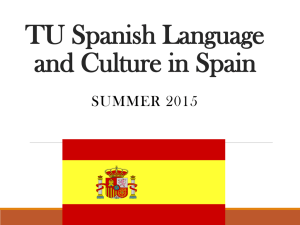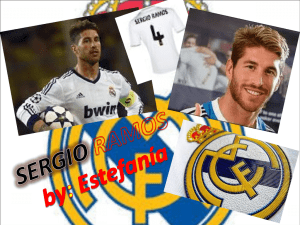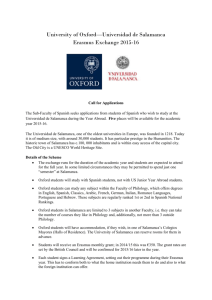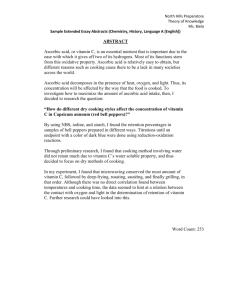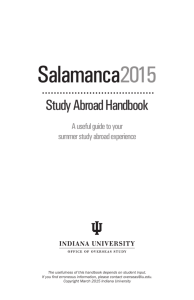MN5404 - University of St Andrews
advertisement
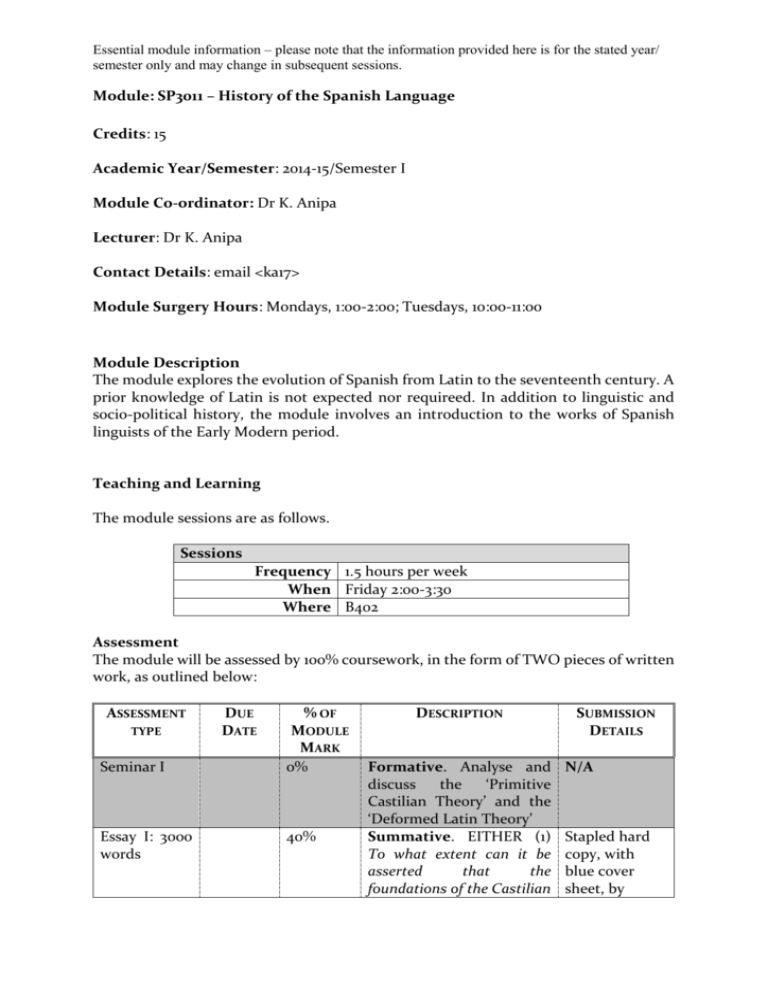
Essential module information – please note that the information provided here is for the stated year/ semester only and may change in subsequent sessions. Module: SP3011 – History of the Spanish Language Credits: 15 Academic Year/Semester: 2014-15/Semester I Module Co-ordinator: Dr K. Anipa Lecturer: Dr K. Anipa Contact Details: email <ka17> Module Surgery Hours: Mondays, 1:00-2:00; Tuesdays, 10:00-11:00 Module Description The module explores the evolution of Spanish from Latin to the seventeenth century. A prior knowledge of Latin is not expected nor requireed. In addition to linguistic and socio‐political history, the module involves an introduction to the works of Spanish linguists of the Early Modern period. Teaching and Learning The module sessions are as follows. Sessions Frequency 1.5 hours per week When Friday 2:00-3:30 Where B402 Assessment The module will be assessed by 100% coursework, in the form of TWO pieces of written work, as outlined below: ASSESSMENT TYPE Seminar I Essay I: 3000 words DUE DATE % OF MODULE MARK 0% 40% DESCRIPTION Formative. Analyse and discuss the ‘Primitive Castilian Theory’ and the ‘Deformed Latin Theory’ Summative. EITHER (1) To what extent can it be asserted that the foundations of the Castilian SUBMISSION DETAILS N/A Stapled hard copy, with blue cover sheet, by Essential module information – please note that the information provided here is for the stated year/ semester only and may change in subsequent sessions. Seminar II 0% Essay II: 3000 words 60% language were laid down in the 13th century? OR (2) Describe the broad composition of the Spanish Lexicon, in terms of categories and sources, drawing on as many examples as you reasonably can. Formative. Compare and contrast the role of Antonio de Nebrija and that of Juan de Valdés in the early linguistic thought of Renaissance Spain Summative. EITHER (1) A past question of your choice, on the internal history of the Castilian language OR (2) An analysis of linguistic features from a medieval text (to be provided by Lecturer). School Office; electronic copy on MMS (via Turnitin) N/A Stapled hard copy, with blue cover sheet, by the School Office; electronic version on MMS (via Turnitin) Week-by-week programme The programme for this module is outlined below: MARTINMAS 2014 PROGRAMME WEEK TOPIC ONE Introduction; Pre-Roman Picture and Latin Ancestry of Castilian Romance TWO Alfonso X el Sabio and the Castilian language THREE Late Medieval and Renaissance Spain (Socio-Political and Cultural); Humanism in Spain FOUR SEMINAR I FIVE Antonio de Nebrija Essential module information – please note that the information provided here is for the stated year/ semester only and may change in subsequent sessions. SIX Juan de Valdés and his Diálogo de la lengua SEVEN Grapho-Phonology EIGHT Morpho-Phonology and Morphology NINE SEMINAR II TEN Forms of Address in the 16th Century ELEVEN Froms of Address in the 16th Century Reading list The core reading list for this module is: BIBLIOGRAPHY Alonso, M. 1979. Diccionario medieval español, Salamanca: Universidad de Salamanca Alvar, M. and Pottier, B. 1983. Morfología histórica del español, Madrid: Gredos Anipa, K. 2001. A Critical Examination of Linguistic Variation in Golden-Age Spanish, New York: Peter Lang Anipa, K. 2000. ‘Tomad and Tomá, etc.: Change and Continuity in a Morphological Feature.’ The Modern Language Review, 95, (2), 389–98 Anipa, K. 2000. ‘A Study of the Analytical Future/Conditional in Golden-Age Spanish.’ Bulletin of Hispanic Studies, LXXVII, 325–337. Anipa, K. 2007. The Grammatical Thought and Linguistic Beheviour of Juan de Valdés. Munich: LINCOM. Anipa, K. 2012. ‘Centrifugal and Centripetal Forces in the Sociolinguistic Configuration of the Iberian Peninsula’, in Standard Languages and Multilingualism in European History, ed. by Matthias Hüning, Ulrike Vogl & Olivier Moliner. Amsterdam: Benjamins, pp. 231-258. Anipa, K. (ed.). Forthcoming 2014. Juan de Valdés, Diálogo de la lengua. A Diplomatic Edition. London: Modern Humanities Research Association. Bahner, Werner. 1966. La lingüística española del Siglo de Oro: aportaciones a la conciencia lingüística en la España de los siglos XVI y XVII. Madrid : Editorial Ciencia Nueva. Corominas, Joan. 1980-91. Diccionario crítico etimológico castellano o hispánico. Madrid: Gredos. Covarrubias, Sebastián de. 1943 [1611]. Tesoro de la lengua castellana o española. Edited by Martín de Riquer. Barcelona: Horta. Echenique Elizondo, Ma. Teresa & Juan Sánchez Méndez. 2005. Las lenguas de un reino: historia lingüística hispánica. Madrid: Gredos. Jackson, Gabriel. 1972. The Making of Medieval Spain. London: Thames and Hudson. Keniston, Hayward. 1937. The Syntax of Castilian Prose. Chicago: University of Chicago Press. Essential module information – please note that the information provided here is for the stated year/ semester only and may change in subsequent sessions. Lapesa, Rafael. 1981. Historia de la lengua española. Madrid: Gredos. Lloyd, Paul. 1987. From Latin to Spanish: Historical Phonology and Morphology of the Spanish Language, vol. 1. Philadelphia: American Philosophical Society. Lope Blanch, Juan Manuel (ed.). 1984. Juan de Valdés, Diálogo de la lengua. Madrid: Clásicos Castalia. Moreno Fernández, Francisco. 2005. Historia social de las lenguas de España. Barcelona: Ariel. Penny, Ralph. 1991. A History of the Spanish Language. Cambridge: CUP. Pountain, Christopher. 2001. A history of Spanish through texts. London: Routledge. Ramajo Caño, Antonio. Las gramáticas de la lengua castellana desde Nebrija a Correas. Salamanca: Universidad de Salamanca, 1987. Wright, Roger (ed.). 1996. Latin and the Romance Languages in the Early Middle Ages. University Park: University of Pennsylvania Press.



